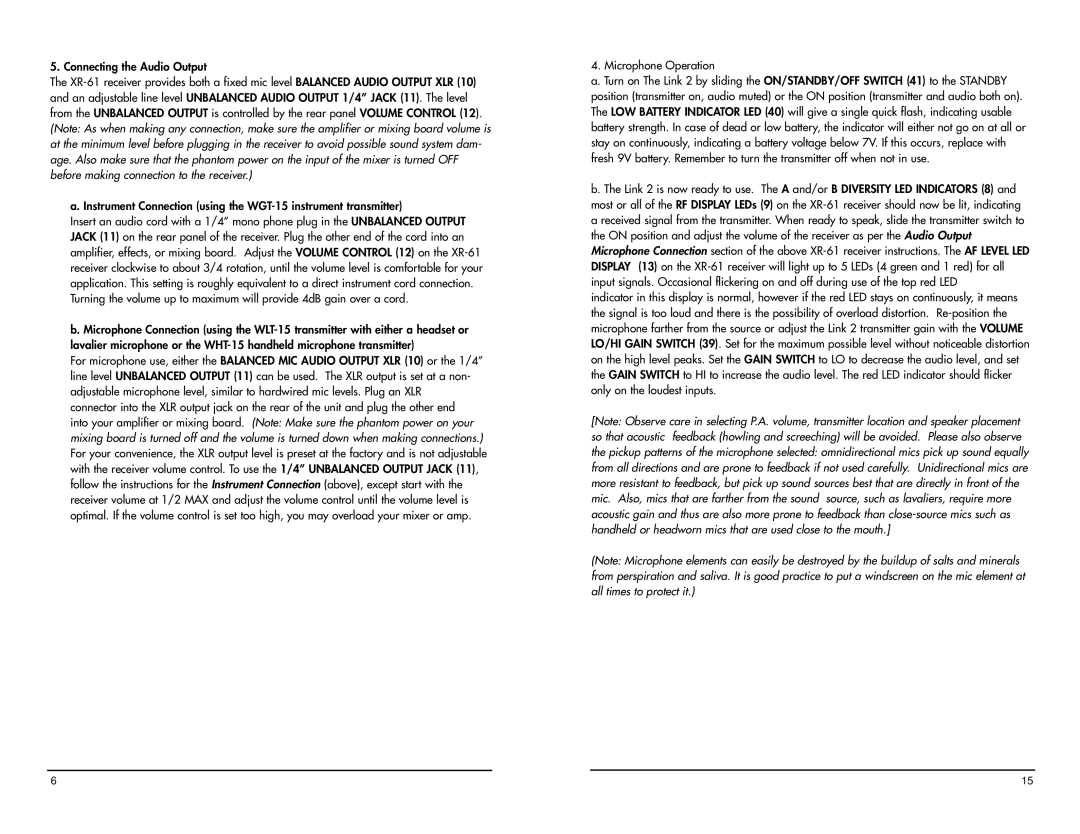5. Connecting the Audio Output
The
a. Instrument Connection (using the
Insert an audio cord with a 1/4” mono phone plug in the UNBALANCED OUTPUT JACK (11) on the rear panel of the receiver. Plug the other end of the cord into an amplifier, effects, or mixing board. Adjust the VOLUME CONTROL (12) on the
b. Microphone Connection (using the
For microphone use, either the BALANCED MIC AUDIO OUTPUT XLR (10) or the 1/4” line level UNBALANCED OUTPUT (11) can be used. The XLR output is set at a non- adjustable microphone level, similar to hardwired mic levels. Plug an XLR connector into the XLR output jack on the rear of the unit and plug the other end into your amplifier or mixing board. (Note: Make sure the phantom power on your mixing board is turned off and the volume is turned down when making connections.) For your convenience, the XLR output level is preset at the factory and is not adjustable with the receiver volume control. To use the 1/4” UNBALANCED OUTPUT JACK (11), follow the instructions for the Instrument Connection (above), except start with the receiver volume at 1/2 MAX and adjust the volume control until the volume level is optimal. If the volume control is set too high, you may overload your mixer or amp.
4. Microphone Operation
a. Turn on The Link 2 by sliding the ON/STANDBY/OFF SWITCH (41) to the STANDBY position (transmitter on, audio muted) or the ON position (transmitter and audio both on). The LOW BATTERY INDICATOR LED (40) will give a single quick flash, indicating usable battery strength. In case of dead or low battery, the indicator will either not go on at all or stay on continuously, indicating a battery voltage below 7V. If this occurs, replace with fresh 9V battery. Remember to turn the transmitter off when not in use.
b. The Link 2 is now ready to use. The A and/or B DIVERSITY LED INDICATORS (8) and most or all of the RF DISPLAY LEDs (9) on the
indicator in this display is normal, however if the red LED stays on continuously, it means the signal is too loud and there is the possibility of overload distortion.
[Note: Observe care in selecting P.A. volume, transmitter location and speaker placement so that acoustic feedback (howling and screeching) will be avoided. Please also observe the pickup patterns of the microphone selected: omnidirectional mics pick up sound equally from all directions and are prone to feedback if not used carefully. Unidirectional mics are more resistant to feedback, but pick up sound sources best that are directly in front of the mic. Also, mics that are farther from the sound source, such as lavaliers, require more acoustic gain and thus are also more prone to feedback than
(Note: Microphone elements can easily be destroyed by the buildup of salts and minerals from perspiration and saliva. It is good practice to put a windscreen on the mic element at all times to protect it.)
6 | 15 |
